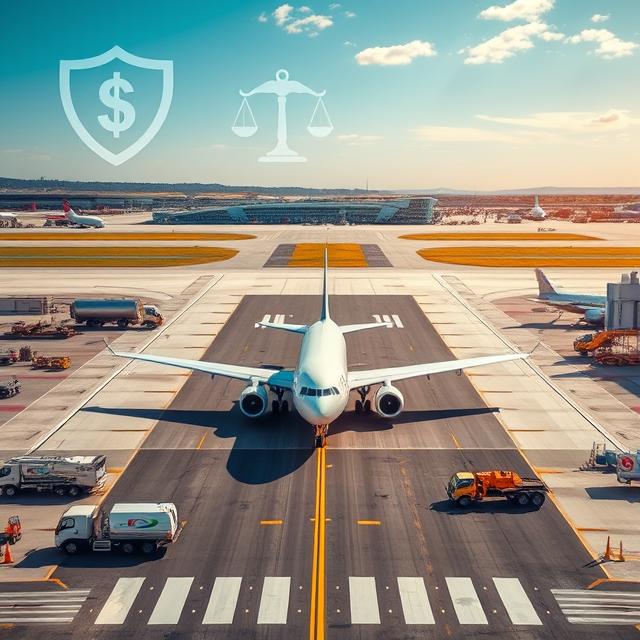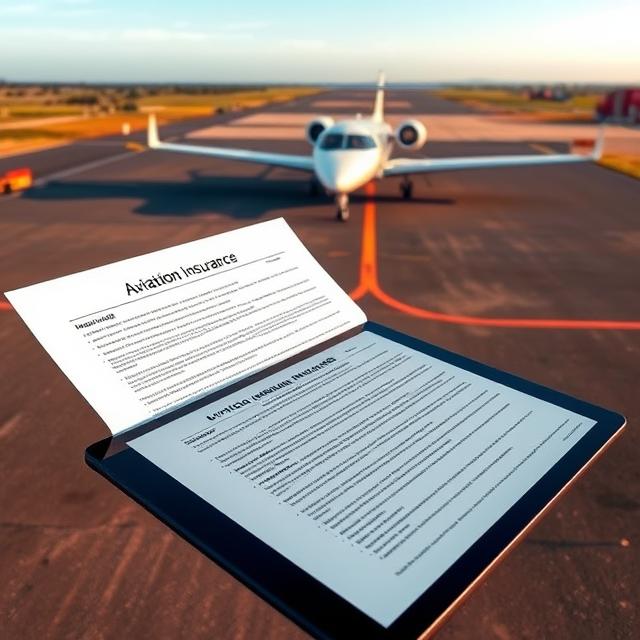
Ensuring safety and security in aviation extends beyond the flight itself and includes all aspects of ground operations as well.
In this case, runway insurance is crucial.
Whether you’re in charge of a private airstrip, a commercial airport, or a fleet of planes, it may be helpful to understand the purpose and benefits of runway insurance in order to prevent big liabilities.
 What is Runway Insurance?
What is Runway Insurance?
-
There is a kind of aviation insurance known as runway insurance.
-
Damages or liabilities that occur on or near runways are covered.
-
Contains incidents that occur while aircraft are taking off, landing, taxiing, or parking.
-
Losses to third parties’ property and other types of damages may also be covered.
 Does Anyone Require Runway Insurance?
Does Anyone Require Runway Insurance?
Airline companies aren’t the only ones that require this insurance:
-
Airport management
-
Proprietors of individual airstrips
-
Known as fixed base operators (FBOs)
-
Businesses that rent out planes
-
Aviation schools
-
Charter aircraft services
-
Corporate jet owners
 What Does Runway Insurance Cover?
What Does Runway Insurance Cover?
Runway insurance often includes:
-
The aircraft sustains harm during taking off or landing.
-
The individual is responsible if their property is damaged by another person.
-
Environmental costs associated with cleaning up fuel spills
-
Deterioration of both ground and hangar machinery
-
The runway might be damaged by aircraft.
-
Vehicle or ground crew-related accidents
-
Allegations of culpability may lead to legal actions.
 What Is Not Relevant?
What Is Not Relevant?
Limitations apply to runway insurance as they do to any other kind of policy:
-
Deliberate injury
-
Unless specified otherwise, terrorism and war
-
Operator incompetence or lack of certification
-
Undisclosed changes to the runway
-
Supernatural deeds (unless they are introduced as a sideshow)
 Varieties of Runway Insurance Policies
Varieties of Runway Insurance Policies
Many different kinds of runway insurance are available to meet your needs:
-
Comprehensive Aerodrome Insurance
Encompasses the airport’s runway, taxiway, and hangars, among other locations. -
Exclusively for the Runway Rules
Stay focused on the runway events alone. -
Rules Concerning the Responsibility of Third Parties
Ends with injury to unaffiliated parties. -
Responsibility for Runway Upkeep
Those in the business of lighting, resurfacing, runway maintenance, etc.
 Runway Insurance’s Advantages
Runway Insurance’s Advantages
-
Decreases potential financial and legal liabilities
-
Helps keep airports and aircraft in working order
-
Boosts respect and trustworthiness
-
Covers the cost of costly repairs and replacements
-
Promotes compliance with aviation rules
-
Backs up investigations and assertions
 How is the Determination of Premiums Made?
How is the Determination of Premiums Made?
Insurers consider many aspects while setting rates:
-
Where and how big the runway is
-
Consistent application
-
What kind of aircraft use the facility?
-
Accident or claim history
-
Protocols for safety and upkeep
 The International Importance of Runway Insurance
The International Importance of Runway Insurance
Global jet traffic is on the increase, making runway insurance more important than ever:
-
This coverage is mandatory at airports in both Europe and the United States.
 Legal Obligations and Rules
Legal Obligations and Rules
-
In some countries, airstrip operators are required to provide minimum coverage.
-
All runways in operation at any one time are required by US FAA regulations to have liability insurance.
-
ICAO standards elevate the level of international runway liability knowledge.
 Extras and Riders
Extras and Riders
You may enhance your coverage by adding optional riders:
-
Payment for runway maintenance
-
Protection for company disruptions
-
Weather and natural catastrophe protection
-
Defense attorney
-
Runway accidents might cause harm to cargo.
 Real-Life Claims Scenarios
Real-Life Claims Scenarios
Runway insurance works as this:
-
After missing the runway, a small airplane crashes into the outside barrier.
-
A service vehicle crashes into a taxiing airliner.
-
Rain has destroyed the runway lighting, which has grounded all flights.
 Help with Buying Runway Insurance
Help with Buying Runway Insurance
-
Keep an eye out for deals from many vendors.
-
Find an aircraft broker and work with them.
-
Understand deductibles and exclusions.
-
Request the policies that are unique to your company.
-
As airport operations evolve, it is necessary to reevaluate annually.
 Preeminent Fashion Insurance Firms
Preeminent Fashion Insurance Firms
Some of the leading vendors in this industry are:
-
Worldwide Aerospace
-
Welcome to AIG Aviation!
-
The USAIG stands for the United States Aircraft Insurance Group.
-
This is Starr Aviation.
-
The Old Republic of Aerospace ✆️
-
Allianz Aviation

 First-Held Testimonials
First-Held Testimonials
“Our FBO just escaped a $1.5 million lawsuit when a private jet ran off the runway. Thanks to our runway insurance, we’re completely covered.”
– Manager of an airport in Texas
“A weather-related illumination problem caused a minor accident. Without insurance, the bill would have been in the hundreds of thousands.”
– Owner of a Small Airport in Florida
 Cutting-Edge Trends in Runway Insurance
Cutting-Edge Trends in Runway Insurance
-
AI-Powered Risk Evaluation: Evaluating danger with the use of sensors and unmanned aerial vehicles.
-
Climate Risk Coverage: Policies now include coverage for things like floods and hail.
-
Digital Claims Management: Mobile apps expedite the claims process.
-
Custom Regional Plans: Tailored to address specific meteorological and geographical risks.
-
Rising Demand: Due to the expansion of private and charter aircraft services.
-
Data-Driven Underwriting: With real-time monitoring.
-
AI & Predictive Modeling: Claims settlements make use of advanced tech.
-
Sustainability Incentives: Financial benefits for eco-friendly airports.
 Instructional Resources
Instructional Resources
-
Aviation safety and insurance whitepapers available for free
-
Videos for teaching airfield staff
-
Webinars about aviation insurance
-
Regular updates and safety tips sent to your inbox every month
 Resolved Common Issues
Resolved Common Issues
Does a runway need insurance?
It’s highly recommended, however the specifics may vary depending on your area’s aviation regulations.
Do parked aircraft fall within its purview?
Some insurance policies will pay for this, especially if you’re using a cab or filling up your gas tank.
How much does it usually cost?
There can be a $2,000 annual premium for a little airfield and $100,000 or more for a major international airport.
 Final Thoughts: Why Runway Insurance Is Crucial
Final Thoughts: Why Runway Insurance Is Crucial
From major international airports to small private airfields, runway insurance is a must-have for airport safety.
Mechanical damage, ground crew mishaps, legal requirements, and environmental issues are all covered by this insurance, so you’ll never be caught unawares.
Rather than seeing it as just another expense, think of it as an essential investment in the continuity, security, and safety of the aviation industry.